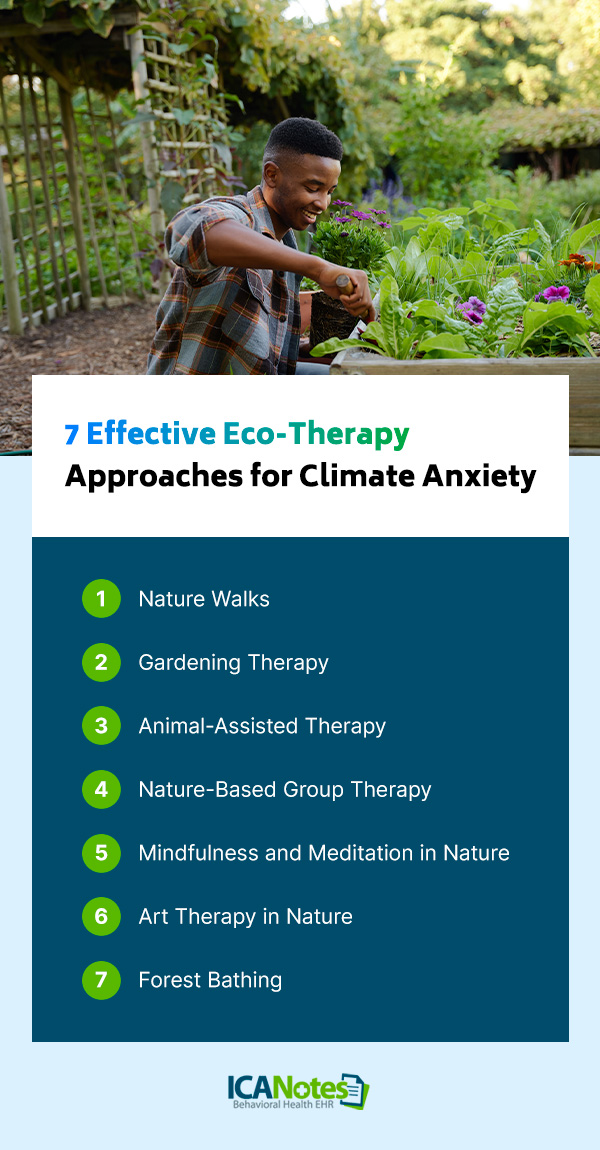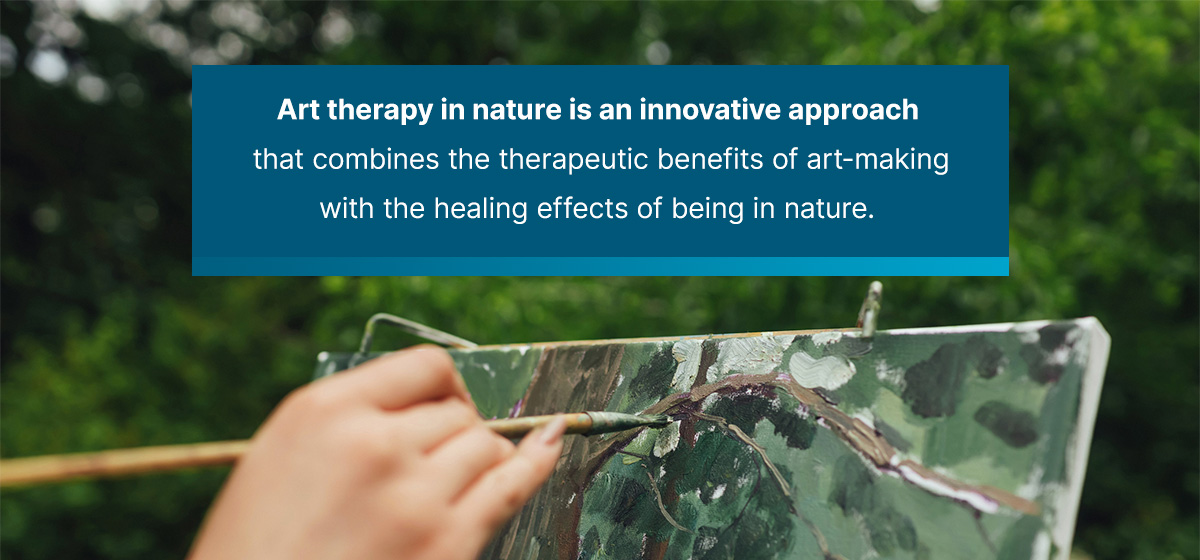Blog > Treatment Strategies > Treating Clients with Climate Anxiety
Treating Clients With Climate Anxiety: Integrating Eco-Therapy Into Traditional Practice
Learn how to help clients manage climate anxiety by integrating eco-therapy into traditional mental health practices, fostering resilience, and strengthening their connection to nature.

Last Updated: February 10, 2025


What You'll Learn
- The psychological impact of climate anxiety and its common symptoms.
- How eco-therapy enhances mental well-being and reduces stress.
- Practical eco-therapy techniques you can incorporate into treatment plans.
- Strategies for guiding clients toward a healthier relationship with the environment.
If your client is struggling with climate anxiety, eco-therapy can be a powerful tool to help them cope. According to the Pew Research Center, 37% of Americans say they care about climate change, while 70% admit that hearing climate news makes them feel sad about what is happening on Earth. These numbers shouldn't come as a surprise. With the increasing frequency of devastating floods, hurricanes, wildfires, and other climate change-related disasters, it's understandable that people are growing more concerned.
However, the challenge is when this concern starts affecting people's day-to-day lives. More mental health practitioners are seeing patients with climate anxiety. While we can't prevent people from seeing some of the fear-inducing news that sometimes triggers this, there are a few practical and useful ways to help them. Below, we explore practical ways to treat clients with climate anxiety by integrating eco-therapy into traditional practice.
What Is Climate Anxiety?
Climate anxiety, also known as eco-grief, eco-anxiety or climate doom, describes the feelings of fear and distress that people experience in response to the impacts of climate change. People with climate anxiety may feel overwhelmingly sensitive and concerned about the planet's future, the ecosystems affected, human existence, and their own lives, as well as those of future generations.
The Lancet Planetary Health reveals that climate anxiety is particularly prevalent among younger generations. This group is often more aware of climate issues and feels a sense of urgency in addressing them.
Common Symptoms of Climate Anxiety
Understanding the symptoms that connect climate change and anxiety can help you provide the appropriate support to your patients. Some of the key eco-anxiety symptoms include:
- Emotional distress: The individual may experience sadness, fear, or worry regarding climate change and the future.
- Anger and frustration: Climate anxiety can result in anger and frustration toward corporations, governments, and other individuals who are perceived to be contributing to the planet's degradation.
- Avoidance: Some people with eco-anxiety may avoid speaking about climate change to try and protect themselves from anxiety and stress.
- Helplessness and hopelessness: The scale of the challenge can leave many people feeling overwhelmed and hopeless as if there is nothing they can do.
What Is Eco-Therapy?
Eco-therapy, also called nature therapy or green therapy, uses the natural environment as a key therapeutic tool. Patients engage with nature in simple ways to improve their mental and emotional well-being. For example, they may garden or take a walk in nature.
The goal of eco-therapy is to help patients forge a deeper connection with nature while enhancing their moods, reducing stress levels, and promoting overall wellness. Nature therapy is based on the belief that engaging with the environment helps us feel better.
Benefits of Eco-Therapy
Eco-therapy can benefit mental, emotional, and physical wellness. Potential advantages include:
- Reduced stress and anxiety: Spending more time in nature can reduce cortisol levels in our bodies, leading to lowered stress and anxiety.
- Improved mood: Spending time in nature increases serotonin and dopamine levels, which can help people feel happy and content.
- Increased self-awareness and connection: Eco-therapy can help patients struggling with depression and anxiety create a deeper connection with themselves and the natural world, leading to increased self-awareness and a sense of belonging.
- Reduced risk of mental health challenges: Regular exposure to nature can help with mental health conditions like depression, attention-deficit/hyperactivity disorder (ADHD), and post-traumatic stress disorder (PTSD). Exposure to nature can help clients manage symptoms associated with these conditions.
7 Effective Eco-Therapy Approaches for Climate Anxiety
Several effective treatments exist to integrate eco-therapy into traditional practice. Some of the methods below work best in one-on-one sessions, while others may be better for group therapy sessions.
1. Nature Walks
We can connect nature and eco-therapy through walking. Nature walks are one of the simplest yet most effective ways to help patients address their climate anxiety. As the name suggests, this therapeutic approach involves assisting clients in connecting with the natural environment while addressing some of the anxiety they feel about the state of the planet.
Nature walks can simply involve walking in nature, or they can be themed. For example, you can organize a "flora and fauna" walk, which may have educational value while helping clients create an emotional connection to all the flowers in the neighborhood.
Walking in nature offers many physical and emotional benefits, including:
- Supporting heart health.
- Promoting healthy cortisol levels.
- Increasing creativity.
- Promoting better sleep.
- Reducing stress levels.
- Improving mood.
- Boosting concentration and attention span.
You can implement nature walks for eco-therapy through simple steps:
- Choose a safe and accessible natural environment like a park, botanical garden, or nature reserve.
- During the walk, guide the experience by encouraging your client to observe their environment, including the colors, sounds, and scents.
- Introduce mindfulness techniques like taking deep breaths of the fresh air and exhaling the tension.
- Encourage conversations about the environment during the walk to allow patients to express their concerns.

2. Gardening Therapy
Gardening therapy involves using gardening activities to address climate anxiety. This approach allows clients to interact with plants and nature through vegetable or herb gardening activities.
Using gardening shouldn't be a surprise, especially considering the many benefits the activity has, such as:
- Increasing exercise.
- Improving mood and reducing stress.
- Boosting sunlight exposure, which can lower blood pressure.
- Improving diet.
Here's how you can implement gardening for eco-therapy:
- Create a designated gardening space that's accessible and safe for clients to use.
- Select native plants and other plants that are easy to grow.
- Facilitate the planting of seeds, watering, weeding, and other garden-related activities.
- Incorporate mindfulness techniques such as encouraging your client to focus on the plants' textures, scents, and colors.

3. Animal-Assisted Therapy
Animal-assisted therapy lets you incorporate animals like dogs, cats, and horses into a treatment plan. With this approach to eco-therapy, patients leverage the bond between humans and animals to help them address psychological challenges.
Multiple studies have shown the incredible benefits that the presence of animals can bring to patients, including:
- Increasing physical activity: For example, dog ownership encourages walking the dog frequently.
- Reducing stress and anxiety: Interacting with pets can alleviate stress and anxiety about climate change.
- Decreasing loneliness: The presence of animals may reduce feelings of loneliness, helping people enjoy a better quality of life.
You can implement animal-assisted therapy with these steps:
- Choose animals that are well-trained and suited for therapeutic settings.
- Create a safe environment for both the pets and patients. This includes considering phobias and allergies.
- Allow your clients to engage in activities such as petting, grooming, or walking the chosen animal. This can help promote relaxation and enhance emotional connections. It can also instill a sense of responsibility and promote a nurturing relationship.
- Discuss how the client feels when interacting with the animal and relate these feelings to their experience with nature and the environment.
4. Nature-Based Group Therapy
Nature-based group therapy can be an alternative if you're already conducting group counseling sessions. This approach combines group therapy with outdoor activities. For example, you could have a collective journaling session where you encourage participants to write about their feelings and experiences with nature. Then, you can follow up with a discussion where everyone can share their feelings and address any emotions related to climate anxiety.
Group therapy can have many benefits, including:
- Enhanced social support: The group dynamic can create a sense of community and connection. It also allows clients to hear about other people's feelings toward climate change, which may give them new perspectives.
- Improved emotional processing: Group therapy encourages open discussions, which can be a great way for clients to address their feelings toward climate change.
- Increased engagement and motivation: The combination of group dynamics and outdoor settings can encourage participants to engage more actively.
You can implement nature-based group therapy by:
- Organizing a small group of up to 12 clients to ensure meaningful interactions.
- Choosing a safe and accessible outdoor location that's conducive to group activities and discussions.
- Planning structured activities like guided nature walks, group gardening, or mindfulness.
- Encouraging open dialogue to facilitate discussions about climate anxiety.
- Incorporating time for each participant to reflect individually at the end of the session.
5. Mindfulness and Meditation in Nature
Mindfulness and meditation are helpful in various forms of therapy. During eco-therapy, this approach can allow your clients to immerse themselves in nature, reduce anxiety levels, and enhance their overall mental well-being.
Mindfulness and meditation practices have many benefits, including:
- Stress reduction: Studies have shown that mindfulness can help lower stress levels.
- Enhanced emotional regulation: Practicing mindfulness can help individuals be more aware of their feelings. This increased awareness can help them better regulate their emotions, especially emotions related to climate change.
- Improved connection with nature: With mindfulness, participants are encouraged to observe everything around them. Practicing it with the calming backdrop of nature can enhance the connection to nature and feelings of responsibility toward the environment.
- Improved ability to stay present: Climate anxiety is often future-focused. Mindfulness helps clients stay focused on the present moment, where they are less likely to feel anxiety about the future.
Here's how you can implement mindfulness and meditation in nature:
- Choose a peaceful setting like a park, garden, forest, or beach.
- Guide your participants through mindfulness exercises, such as focusing on their breath, bodily sensations, and the sounds of nature.
- Include meditation techniques like walking meditation (walking slowly and mindfully through your chosen environment) or sensory awareness (encouraging your participants to close their eyes and focus on their other senses to experience the world around them).
- Encourage participants to express their feelings, paying particular attention to their connection to nature.

6. Art Therapy in Nature
Art therapy in nature is an innovative approach that combines the therapeutic benefits of art-making with the healing effects of being in nature. This form of eco-therapy encourages participants to engage in creative activities while fostering a deeper connection with the environment.
Art therapy in nature can have many benefits, including:
- Emotional expression: Engaging in art-making allows participants to express complex emotions about climate change.
- Enhanced connection to nature: Creating art pieces can encourage participants to observe and appreciate nature more.
- Stress reduction: Creating a piece of artwork can encourage patients to focus on the activity and distract themselves from stressful thoughts, leading to reduced stress.
To implement art therapy in nature, you can:
- Choose a tranquil outdoor environment.
- Provide your clients with art supplies, including colored pencils, watercolors, crayons, or markers, to create their eco-art.
- Allow your clients to create artwork that reflects their feelings about nature and sustainability.
- Speak about the artwork and the emotions tied to it to encourage self-awareness and reflection.
7. Forest Bathing
Forest bathing, also known as "shinrin-yoku," is a term that emerged from Japan and encourages people to immerse themselves in a forest atmosphere. Taking in the forest environment can help improve mental and emotional health.
Shinrin-yoku has many potential benefits, including:
- Reducing anxiety: Forest bathing calms the nervous system and can reduce anxiety.
- Lowering cortisol levels: Spending time in the forest can reduce stress levels by lowering cortisol levels in participants.
- Improving mood and emotional well-being: Spending time in nature can enhance a person's mood and increase feelings of happiness.
You can implement forest bathing into a client's treatment plan by:
- Selecting a safe and accessible forest.
- Guiding the experience by encouraging participants to engage their senses with deep breathing to notice the sounds, smells, colors, and textures of the environment.
- Encouraging a mindful walk through the forest.
- Asking your clients to reflect on what they observed and share how they felt about it.
Why Trust ICANotes for Documenting Your Eco-Therapy Notes?
Accurate note-writing and documentation are essential in ensuring a treatment's success. As a mental health professional, each session will require you to make important detailed notes about:
- Your client's needs.
- The types of eco-therapy best suited for them.
- The approaches you've tried.
- The overall progress of your sessions.
ICANotes has more than 20 years of experience partnering with behavioral health clinicians and organizations. Our electronic health record (EHR) offers mental health professionals a more seamless way to create legible, accurate, and secure notes throughout patient treatment. Our mission is to provide you with the most clinically robust and easy-to-use charting solution so you can confidently treat your clients, knowing that you have a solid documentation partner in place.
Integrate Eco-Therapy to Help Your Clients With Climate Anxiety
Eco-therapy approaches — such as nature walks, gardening, and animal-assisted therapy — can help alleviate climate anxiety and enhance overall mental well-being. As a mental health professional, you can incorporate ICANotes into your practice as a trusted partner to help you manage your documentation.
Our EHR features easy-to-use mental health templates and notes to help streamline the documentation process. This makes it easier to stay organized and helps you remember key information for each client. With ICANotes, you can efficiently offer holistic care and enhance the quality of life for individuals living with climate anxiety.
Get Your Free 30-Day Trial
Related Posts
Lindsay Rutter, MA, NCC, LPC, is a Licensed Professional Counselor with a Master's Degree in Clinical Counseling. She has nearly 15 years of clinical and supervisory experience with extensive knowledge of mental health diagnoses, their etiology and evidence-based treatments. Lindsay is the Clinical Director of a nonprofit community mental health center and the owner of a private practice in Chester County, PA.







